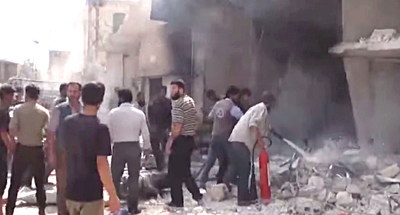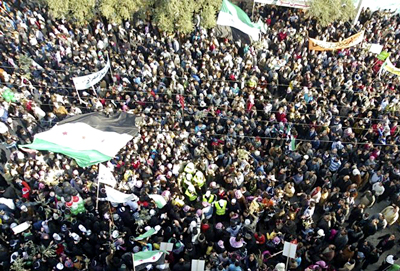
Vol. 79/No. 37 October 19, 2015
(lead article)
Moscow’s bombs shore up
brutal Assad gov’t in Syria
Consequence of Washington’s ‘reset’ deals


The consequences of the Obama administration’s accord with the Iranian government and “reset” with Moscow are unfolding in the expansion of Russian military intervention in Syria. Daily airstrikes by Russian warplanes since Sept. 30, ostensibly directed against Islamic State, have mainly targeted other opponents of Syrian President Bashar al-Assad’s brutal regime.
At the same time, the U.S. “mistake” in bombing a Doctors Without Borders hospital in northern Afghanistan underlined the unintended but deadly repercussions of Washington’s increased use of bombs and drones to defend its imperialist interests in the region, while aiming to minimize U.S. “boots on the ground.”
Alongside its airstrikes, Moscow is reinforcing its naval base in Tartus on Syria’s Mediterranean coast, where it has operated since the early 1970s, and deploying dozens of high-precision jetfighters, tanks, artillery and large transport aircraft. According to Russian and Syrian news reports, airborne troops, special forces and military “volunteers,” along with amphibious landing craft, are also on their way.
Moscow intervened as Assad’s regime was losing ground. It controls only 25 percent of the country. Opposition forces, including some funded by Washington, captured key areas of northwestern Syria earlier this year. Most of the Russian bombings have focused on these areas in Idlib province and around the cities of Hama and Homs. The nearest Islamic State-controlled territory is more than 100 miles away.
Russian airstrikes in the village of Telbiseh near Homs Sept. 30 hit Free Syrian Army sites, killing dozens of civilians, many of the Turkmen minority, said a statement issued by the Syrian Turkmen Assembly. The group’s armed wing has been battling both Assad’s forces and the Islamic State.
Russian officials say they are coordinating their offensive with the governments of Iran and Iraq from a newly established center in Baghdad. In an Oct. 1 interview with France 24 TV, Iraqi Prime Minister Haider al-Abadi said he would “welcome” the extension of Russian airstrikes to Iraq.
The Iranian government, which also backs Assad’s regime, has recently sent hundreds of troops to Syria. There are reports in Reuters and elsewhere that Tehran intends for them to join a ground offensive with thousands of Lebanese-based Hezbollah troops under cover of Russian airstrikes.
Roots of Syrian civil war
The civil war in Syria has killed about 250,000 people while displacing more than half the country’s prewar population of 23 million.The struggle began in March 2011 with widespread protests demanding political rights and an end to Assad’s dictatorial rule. The actions, many led by youth, cut across religious lines, involving Shia, Sunnis, Kurds, Druze, Alawites and others. In one of the largest protests, about half a million people rallied in Hama. Assad responded with bombings, arrests and killings.
Opposition forces sought to meet the onslaught by organizing the Free Syrian Army, which took control of parts of northern Syria, including areas around the country’s largest city Aleppo. As government assaults escalated, the FSA fractured. Shifting coalitions of Islamist as well as secular groups have been competing for territory and fighting government forces since then. In the chaos, the reactionary Islamic State was able to seize swaths of territory in Syria and Iraq.
The Assad regime has relied on use of shrapnel-filled barrel bombs, which maximize civilian casualties. In 2013 the Obama administration backed off threats to intervene, after Russian President Vladimir Putin brokered a deal to supposedly stop Moscow’s ally from using chemical weapons.
From January to August this year Assad’s forces were responsible for 9,107 civilian deaths, according to the Syrian Network for Human Rights, more than seven times greater than those killed by Islamic State over the same period.
Among those spearheading the fight against both the Syrian government and Islamic State are the Kurds. They ended the Assad regime’s control of Kurdish areas in northeastern Syria in 2012. And they’ve beaten back Islamic State over hundreds of miles of territory near the Turkish border.
Obama, Putin meeting
Washington and Moscow agree on “some fundamental principles” for Syria, Secretary of State John Kerry told the media Sept. 29 after a meeting between Obama and Putin.“There was agreement that Syria should be a unified country, united, that it needs to be secular, that ISIL [Islamic State] needs to be taken on, and that there needs to be a managed transition,” Kerry told MSNBC, adding that differences remain on what the outcome of such a transition would be.
But the rapidity and force with which Moscow’s forces have moved, and their focus on non-IS opponents of Assad, has taken Washington and its allies by surprise.
U.S. forces continue daily bombings against Islamic State in Syria and Iraq. The White House acknowledges that every attempt to put together a Syrian ground fighting force it can rely on has failed. When Syrian fighters are told they will be restricted to fight IS, far away from Assad’s troops in the west where Moscow’s bombs are falling, they take off.
Meanwhile, U.S. officials have been scrambling to explain why a U.S. gunship targeted a hospital in Kunduz, Afghanistan, Oct. 3 while supporting Afghan troops fighting to retake the city from Taliban forces. The bombardment continued for 30 minutes, despite repeated pleas to stop by Doctors Without Borders. At least 12 staff and seven patients were killed and dozens injured in the attack.
Front page (for this issue) | Home | Text-version home